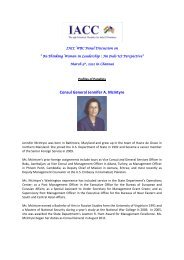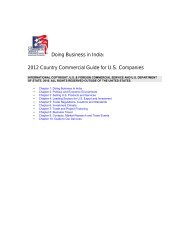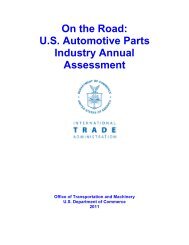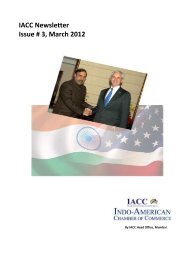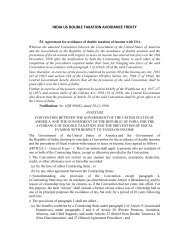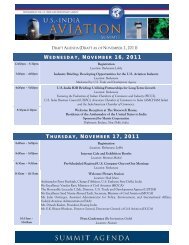Importing into the United States - Indo-American Chamber Of ...
Importing into the United States - Indo-American Chamber Of ...
Importing into the United States - Indo-American Chamber Of ...
You also want an ePaper? Increase the reach of your titles
YUMPU automatically turns print PDFs into web optimized ePapers that Google loves.
■<br />
■<br />
■<br />
Products of <strong>American</strong> fisheries that are<br />
free of duty.<br />
Products of possessions of <strong>the</strong> <strong>United</strong><br />
<strong>States</strong>.<br />
Products of <strong>the</strong> <strong>United</strong> <strong>States</strong> exported<br />
and returned.<br />
■ Articles valued at not more than $200 (or<br />
$100 for bona fide gifts) that are passed<br />
without entry.<br />
Special country-of-origin marking rules<br />
for goods of a NAFTA country are addressed in<br />
Customs publication No. 571, NAFTA: A Guide<br />
to Customs Procedures.<br />
34. SPECIAL MARKING REQUIREMENTS<br />
The country of origin marking requirements<br />
are separate and apart from any special<br />
marking or labeling required on specific products<br />
by o<strong>the</strong>r agencies. It is recommended that<br />
<strong>the</strong> specific agency be contacted for any special<br />
marking or labeling requirements.<br />
Certain articles are subject to special<br />
country of origin marking requirements: Iron<br />
and steel pipe and pipe fittings; manhole rings,<br />
frames, or covers; and compressed gas cylinders<br />
must generally be marked by one of four<br />
methods: die-stamped, cast-in-mold lettering,<br />
etching (acid or electrolytic) or engraving. In<br />
addition, none of <strong>the</strong> exceptions from marking<br />
discussed above are applicable to iron and steel<br />
pipe and pipe fittings.<br />
The following articles and parts <strong>the</strong>reof<br />
shall be marked legibly and conspicuously to<br />
indicate <strong>the</strong>ir origin by die-stamping,<br />
cast-in-<strong>the</strong>-mold lettering, etching (acid or electrolytic),<br />
engraving, or by means of metal<br />
plates that bear <strong>the</strong> prescribed marking and<br />
that are securely attached to <strong>the</strong> article in a conspicuous<br />
place by welding, screws, or rivets:<br />
Knives, clippers, shears, safety razors, surgical<br />
instruments, scientific and laboratory<br />
instruments, pliers, pincers, and vacuum containers.<br />
Watch movements are required to be<br />
marked on one or more of <strong>the</strong> bridges or top<br />
plates to show (1) <strong>the</strong> name of <strong>the</strong> country of<br />
manufacture, (2) <strong>the</strong> name of <strong>the</strong> manufacturer<br />
or purchaser, and (3) in words, <strong>the</strong> number of<br />
jewels, if any, serving a mechanical purpose as<br />
frictional bearings.<br />
Clock movements shall be marked on <strong>the</strong><br />
most visible part of <strong>the</strong> front or back plate to<br />
show (1) <strong>the</strong> name of <strong>the</strong> country of manufacture,<br />
(2) <strong>the</strong> name of <strong>the</strong> manufacturer or purchaser,<br />
and (3) <strong>the</strong> number of jewels, if any.<br />
Watch cases shall be marked on <strong>the</strong> inside<br />
or outside of <strong>the</strong> back cover to show (1) <strong>the</strong><br />
name of <strong>the</strong> country of manufacture, and (2)<br />
<strong>the</strong> name of <strong>the</strong> manufacturer or purchaser.<br />
Clock cases and o<strong>the</strong>r cases provided for<br />
in Chapter 91, HTSUS, are required to be<br />
marked on <strong>the</strong> most visible part of <strong>the</strong> outside<br />
of <strong>the</strong> back to show <strong>the</strong> name of <strong>the</strong> country of<br />
manufacture.<br />
The terms “watch movement” and “clock<br />
movement” refer to devices regulated by a balance<br />
wheel and hairspring, quartz crystal, or<br />
any o<strong>the</strong>r system capable of determining intervals<br />
of time, with a display or system to which<br />
a mechanical display can be incorporated.<br />
“Watch movements” include devices that do<br />
not exceed 12 mm in thickness and 50 mm in<br />
width, length, or diameter; “clock movements”<br />
include devices that do not meet <strong>the</strong> watch<br />
movement dimensional specifications. The<br />
term “cases” includes inner and outer cases,<br />
containers, and housings for movements,<br />
toge<strong>the</strong>r with parts or pieces, such as, but not<br />
limited to, rings, feet, posts, bases, and outer<br />
frames, and any auxiliary or incidental features,<br />
which (with appropriate movements)<br />
serve to complete <strong>the</strong> watches, clocks, time<br />
switches, and o<strong>the</strong>r apparatus provided for in<br />
Chapter 91, HTSUS.<br />
Articles required to be marked in accordance<br />
with <strong>the</strong> special marking requirements in<br />
Chapter 91 must be conspicuously and<br />
indelibly marked by cutting, die-sinking,<br />
engraving, stamping, or mold-marking. Articles<br />
required to be so marked shall be denied entry<br />
68 U.S. CUSTOMS SERVICE








